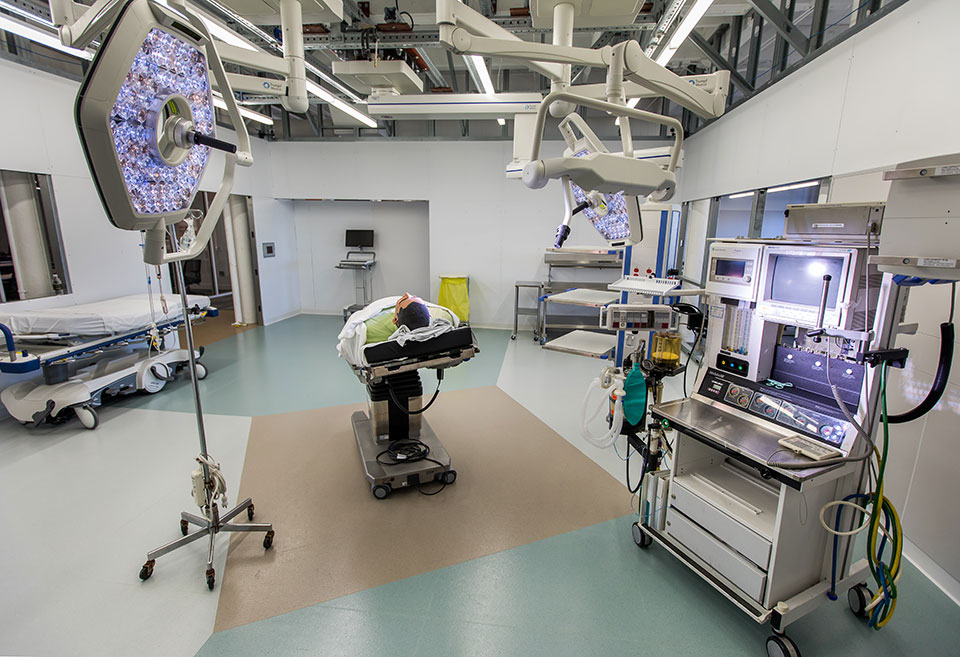A joint research team including faculty from Clemson University and the Medical University of South Carolina has unveiled a high-fidelity, mock operating room at the Clemson Design Center in Charleston. The prototype is based on three years’ worth of research of past literature on operating room functionality; observation of best practices in updated, modernized operating rooms; and input from nurses, doctors and anesthesiologists on how the new operating room should function.
Lead investigators on the joint MUSC-Clemson project, which is called Realizing Improved Patient Care Through Human-Centered Design in the OR, are Scott Reeves, M.D., the John E. Mahaffey, M.D. endowed chair and MUSC Department of Anesthesia and Perioperative Medicine chairman; and Anjali Joseph, Ph.D., the Spartanburg Regional Health System endowed chair in architecture and director of the Center for Health Facilities Design and Testing at Clemson University.
The goal of project is to analyze every aspect of the current operating room standard and redesign it with efficiency and improved patient care in mind. Leaders from the South Carolina Surgical Quality Collaborative, led by Mary Lockett, M.D., will help vet the group’s findings.
“We’ve taken a comprehensive, evidence-based approach to redesigning operating rooms to create an evidence-based design solution that simultaneously tackles problems related to workflow, equipment design and the built environment — major areas that impact patient safety outcomes,” Joseph said.
The new operating room design aims to:
- Improve staff safety by reducing clutter and trip hazards
- Reduce surface contamination through material selection and improved ergonomics
- Support team communication by refining sightlines and visibility
- Adapt as care delivery and technology change without significant cost or disruptions through use of modular wall panels
The team of researchers, engineers and clinical specialists involved in this project received a four-year, $4 million research grant from the Agency for Healthcare Research and Quality in 2015 to research and develop a safer, more efficient operating room.
Dr. Scott Reeves of MUSC and Dr. Anjali Joseph of Clemson examine the equipment in the mock OR.
“We want to establish a new standard on what should be considered when you build an OR, and the first two years of this project have been dedicated to that end,” Reeves said. “Now in our third year, we’ve designed and constructed a simulation of this future state OR, complete with mannequins and software that will enable comprehensive testing of the design. It’s exciting to be at this point in the project and we are eager to start collecting more data and feedback.”
Most operating rooms across the nation consist of a cramped, square white room with a patient bed in the middle of the space. Doctors say they are antiquated, confined spaces that do not accommodate today’s high-tech surgical equipment, complex processes and human interactions. Distractions and interruptions are major causes of mistakes during surgery and often lead to patient harm. Additionally, up to five percent of patients who undergo surgery will develop a surgical site infection.
Smarter, evidence-based design has the potential to make operating rooms safer for patients and health care personnel alike, Joseph said. “The standard OR does not support the needs of the patients, nurses or surgeons, so we’re excited to have reached the testing point for these new concepts and to demonstrate what we’ve learned through this mock OR and simulation experience.”
The first-of-its-kind project covers three specific areas of research designed to improve patient care and efficiency in a future operating room design:
- Unmasking of anesthesia-related alarms and communications
- Traffic flow and door openings
- An integrated operating room suite design
The design and fabrication of the prototype room were developed by a team of graduate students in the Architecture + Health program at Clemson under the direction of Alumni Distinguished Professor David Allison, in collaboration with the research team, MUSC clinicians and industry partners.
Reeves and Joseph agree: This groundbreaking project would not have become a reality without people teaming up to improve patient safety and care.
“When institutions of excellence align their interests and work together to achieve a common goal, patients win,” Reeves said.
“It has been a really wonderful relationship between Clemson and MUSC that has made this all possible,” Joseph said. “We have the researchers, expertise and the manpower to do all of this, and MUSC has the leadership and know-how it takes to implement it.”

